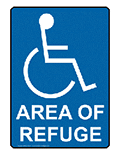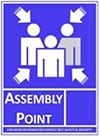Instructions to occupants in case of fire
When you discover a fire in the building:
- Leave the fire area immediately.
- Sound the fire alarm by activating the nearest red fire alarm pull station.
- Call the Fire Department, dial 911 from a safe location and give address: (BCIT Building____, (street address), (Municipality).
- Close doors behind you while leaving the building via the nearest safe fire exit.
- Remain calm and assist others.
- Proceed directly to the Designated Assembly Area
If you hear the fire alarm:
- Leave the building immediately via the nearest safe fire exit
- Close doors behind you while leaving the building
- DO NOT use the elevators
- Remain calm and assist others.
- Proceed directly to the Designated Assembly Area
General information
While exiting, walk, do not run. Shut all doors behind you and alert those who have difficulty hearing that an emergency evacuation of the building is under way. Proceed along corridors and through exits in a quiet and orderly manner. High-heeled shoes are hazardous while proceeding downstairs, and it is advisable to remove them before entering the stairwell. Do not push or jostle.
Assist persons requiring assistance to reach the nearest safe exit.
When you have reached the outside of the building, move away from the doorway to allow others behind you to emerge from the exit and proceed to the assembly area.
DO NOT use the elevators
DO NOT RE-“ENTER THE BUILDING FOR ANY REASON until you have been advised to do so by the Fire Department.
Designated Assembly areas (DAA) are situated around campus as muster points in case of building evacuation. The DAA allows people to safely congregate leaving a clear path for emergency personnel access.
View map of campus designated assembly areas [PDF]
Pictures of the Burnaby Campus temporary assembly points can be viewed on ShareSpace.

All BCIT buildings have areas of refuge. These are found in building Fire Separations and are generally found in building stairwells.Individuals with mobility impairments should access these areas during evacuations and wait for emergency fire personnel.
Schools/Departments who require additional life safety equipment, including fire extinguishers, must make a request for review by Facilities Services. All associated costs including installation, the required Fire Plan updates, and ongoing inspection and maintenance activities will be the responsibility of the requesting department.
Fire drills occur on a regular basis in order to prepare the BCIT community for a fire event and to comply with legislative requirements.
Portable fire extinguishers must be ready to use at all times. Facilities maintenance performs monthly and annual checks of fire extinguishers, however it is good practice for area occupants to periodically inspect PFEs in their work areas.
- Ensure that the PFEs are mounted on the hanger or bracket and that the hanger or bracket is securely anchored.
- If located within a fire extinguisher cabinet, make sure the cabinet is NOT locked.
- Ensure that access to the PFE is not obstructed and that the PFE is not obscured from view.
- Visually examine the extinguisher to make sure there is no obvious physical damage, leakage or a clogged nozzle.
- Check the pin and plastic seal on the handle. The pin should be secured into the handle with a plastic tie, indicating that the Fire Extinguisher has not been previously discharged.
- For Carbon Dioxide and other extinguishers that do not have a pressure gauge, check for fullness by weighing or by lifting it up to check its ‘heft’ or fullness.
- For ABC type extinguishers, check the gauge to verify that the arrow is in the green area, indicating that it is has the appropriate amount of pressure to discharge the extinguishing agent.
• Check to make sure that the fire extinguisher has been inspected within the last year by the vendor. The inspection tag on the device should be up to date.
If any problems are noted, please submit a work request to BCIT Facilities.
The answer, in most cases, is yes! Not only can these items present fire hazards, storage of equipment or materials in hallways, even on a temporary basis, can seriously impact the safety of building occupants and first responders during a fire event. Consider, for example, that if a fire occurs, visibility will be greatly reduced. If you are trying to exit the building–perhaps by crawling on the floor to minimize your exposure to smoke–those items in the hallway could impede your ability to get out quickly. Or, if they’re easily movable (rolling carts, for example) and you bump into them, they could actually obstruct your exit access.
Also, during a fire the first responders may be dragging fire hose down the corridor. If there is storage or easily moved equipment located in the hallway, the hose could catch on these stored items and either obstruct the hallway of impede response efforts.
In general, any furniture located in the means of egress must be approved for that location through Facilities and Campus Development. Never store anything in stairwells!
In general, there is no employer expectation for employees to attempt to extinguish a fire or otherwise stay in their workplace for any reason upon being notified of a fire emergency.
Certain employees, however, may need to be trained to use fire extinguishers based on their job duties or work location. Persons who oversee hot work operations (welding, cutting or brazing), who work in fuel dispensing areas, or where there are unusual fire hazards, for example, would fall in this category.
If you feel that you require a Fire Extinguisher in your area, please contact BCIT Facilities Maintenance to have your area evaluated for Portable Fire Extinguisher needs. This evaluation will include determining the type and size of the extinguisher that would be appropriate for the space and operation.
Yes, training is available upon request. Training is encouraged for personnel who are expected to use fire extinguishers, such as chemical laboratory personnel, those performing welding/cutting (e.g. “hot work”). Please contact Samantha Garofalo to arrange training.
After an extinguisher is placed in an area, it is scheduled to be inspected and tested periodically by Facilities Maintenance. If extinguishers in your area require servicing, please submit a BCIT Facilities work request.
Many buildings on campus have uneven heat distribution, resulting in occupants to bring electric space heaters into their work areas. Employees are encouraged to work with Facilities Maintenance to correct heating and cooling issues in their work areas. Although the practice of bringing heaters into the work area is discouraged, it is recognized that certain conditions require this measure to be taken. Anyone using space heaters should be aware that, if used improperly, electric space heaters can increase the risk of fire significantly. If you choose to use a space heater, be sure you comply with the following:
- The heater must be electrically powered and listed by Underwriters Laboratories (UL).
- Space heaters with heated metal coils are not permitted. A guard or screen must cover the heating element.
- Space heaters may only be located on the floor. Heaters located on filing cabinets, tables, desks or equipment are more susceptible to being knocked over, resulting in accidents or fires.
- Electric space heaters must be plugged directly into an approved receptacle- not into extension cords.
- Electric Space heaters shall have tip-over automatic safety cut-offs.
- The electric cord for the heater must be in good condition. If cords or plugs are damaged, the unit must be removed from service. Do not run the electric cord under carpets or paper, or across aisles or other walking paths.
- A minimum of 3 feet clearance is required around the heater. Placing an electric space heater near or in contact with combustible materials can be a fire hazard. Never place anything on top of a space heater.
- The manufacturer’s use and care booklet must be read and followed.
- Only electric heaters are allowed. Gasoline, kerosene and propane heaters are not permitted.
- The heating element cannot exceed a temperature of 212°F (100°C).
Please contact BCIT Facilities for help with this calculation.
A false alarm is an intentional activation of a fire alarm when no emergency exists. This does not include malfunctions of the alarm system. False alarms have the potential for causing panic and harm to building occupants unnecessarily. Anyone caught making a false alarm may be subject to criminal charges and referred for disciplinary action per BCIT policy.
BCIT has 7150-PR4 – Smoking Location procedures [PDF]. This procedure outlines that smoking is prohibited inside all BCIT buildings and vehicles and within 6 meters of building entrances, open windows, eating areas (with the exception of the Student Association Pub patio), building air intakes, parkades, thoroughfares and covered walkways. Outdoors, discarded smoking materials carelessly tossed in waste containers or into landscaping can easily start a fire. Use approved waste containers to discard all smoking materials properly.
Building fire plans and evacuation maps are maintained by the Safety, Security and Emergency Management Department. Please contact BCIT_Safety_and_Security@bcit.ca for any related inquiries.
